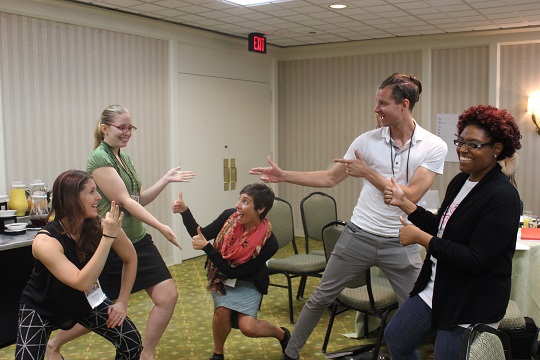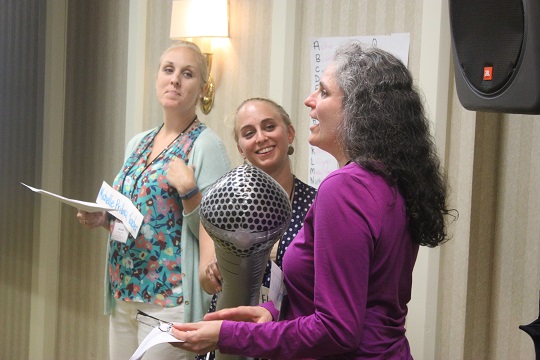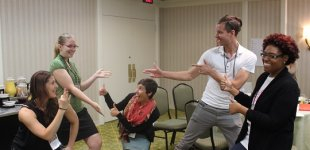
The Arts for Learning Initiative is a year-long program designed to bring teachers, artists and administrators together to gain an understanding of the pedagogy and arts integration methods that serve as the foundation for the
Arts for Learning (A4L) curriculum while also learning strategies for implementing these practices in new and innovative ways in their own classrooms. The Arts for Learning initiative is made possible by a grant from JCPenney Cares.
On July 20 – 22, Young Audiences Arts for Learning - in partnership with Young Audiences of Houston - hosted its second national professional learning session at the Hilton Houston Post Oak Hotel in Houston, Texas. The first seminar, offered this past January, gave the twelve participating districts’ teams the chance to experience a deep dive exploration and introduction to the basic structure and content contained within Arts for Learning Curriculum. Building off of the previous session, Houston attendees were given the opportunity to focus more on what is necessary to put the curriculum into practice and also gave each district’s team the opportunity to share implementation tips, examples of “best practices” and lesson differentiation tactics that they found particularly effective, based on their own experiences in the classroom.
One of the themes that was inextricably woven through each presentation and each team’s narrative was the ability of the arts-integrated lessons to reach students in a multitude of different ways that hadn’t been available before. Students who may not have traditionally been the highest achieving or the most engaged in class were now experiencing real growth in both achievement and engagement, and were more excited about coming to class and learning. Consistent with previous research findings, A4L is more interesting and fun than traditional learning methods, while also proving to be more effective in improving their knowledge and skills of difficult literacy concepts.
Eric Booth, an award-winning arts in education expert known by many as “the father of the teaching artist profession” defines art as “making stuff that you care about”. This definition may seem a bit simplistic, but it does a great job of describing the impact that the arts integrated lessons have on participating students. The Arts for Learning Curriculum guides students to create and reinforce meaningful and personal connections with the texts they read and the concepts they learn through arts activities that let them express the “stuff that they care about”.

Students are much more likely to care about the information they are learning if it is readily accessible to them. There are many examples of studies and articles which break learning down into three main segments – auditory, visual, and kinesthetic - and use these as a way to chart different ways that students are able to learn most effectively. In most traditional classrooms, the most prevalent style of teaching that can be found is predominantly auditory. Simply put, this means that a teacher stands in front of the class and recites facts to their students, usually in the form of a lecture, about specific topics. The students are then asked to internalize this information and be able to recall it at a later date during an exam. While this may work for some learners, it often neglects the students who learn more readily when they can see things drawn or written out or when they actively participate in an activity and reinforces the concepts covered. The arts are capable of leveling the playing field by expanding learning opportunities for all students and allowing them to experience the different learning styles to which they are most receptive.
Young Audiences Arts for Learning National Director of Education, Research and Professional Development Jan Norman summed up why the Arts for Learning Curriculum is so effective for a wide variety of students.
“Arts for Learning is a unique example of real arts integration that brings life and meaning to texts and abstract concepts by using the essential elements of creative problem solving, reflective thinking, and the relevance of personal feelings.”
Another aspect of the A4L curriculum that was explored by attendees in Houston is the great adaptability of each of the lessons. Included in the curriculum are built-in differentiation options which facilitate the use of alternate texts and art forms. This allows the co-teaching pair of teacher and teaching artist to use their knowledge of their students to customize the lessons to ensure the best learning experience for each child. Throughout the course of the session, many of the co-teaching teams shared with the other attendees stories of the various ways they had customized the lessons they were teaching to better suit their specific class. This ability to customize the lessons gives the curriculum life beyond the pages of the text and allows for it to grow with the classes that are using it.
Over the course of the three day seminar, the attendees had the opportunity to learn from well-established teaching artists and education experts and collaborate with their peers in order to gain valuable insight and techniques to bring back to their own classrooms.
Click here for more information about the Arts for Learning Initiative and the Arts for Learning Curriculum.




